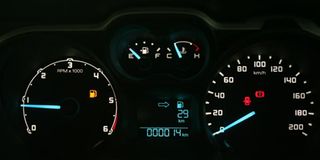Pocket dictionary :Display panel

A well-lit display panel. Photo By Abubaker Lubowa
What is an instrument display? Do cars have instruments? Good questions, I should add. As it is often said, some car parts or features sound pretty obvious, every one of us should know something about them, but that is always not the case. Obvious as they may sound, if someone put you on the spot to name some, you may not have a clue.
Today, let’s look at one of those perceived as “obvious” because it is pretty much in your face if you are driving and you use it literally everyday-the instrument display. Simply put, this display is part of the dashboard, in fact it takes almost half (in some cars) the size of the entire dashboard. The dashboard is that long part comprising the steering wheel, the glove box, radio (entertainment display), and the instrument display itself.
The instrument display can also be called an electronic instrument cluster, digital instrument panel , fascia, control panel or digital dash for short. It is a set of instrumentation, including the speedometer, that is displayed with a digital readout rather than with the traditional analog gauges. An online source explains that the instrument cluster/display contains gauges such as a speedometer, tachometer, odometer and fuel gauge, and indicators such as gearshift position, seat belt warning light, parking-brake-engagement warning light and an engine-malfunction light (also known as check engine signal). There may also be indicators for low fuel, low oil pressure, low tyre pressure and faults in the airbag (SRS) system.
When you switch on the headlamps, the instrument display will automatically be lit as well. Different manufacturers use different colours in the display including green, orange, red, yellow and blue among others. The display is in most cases located on the side of the steering wheel either on the extreme left or right depending on if the car is left or right hand sided.
However, some Japanese manufacturers have some displays right in the middle of the dashboard! This is the case with the first generation Nissan X-Trail and many Toyota models including the first generation Toyota Vitz. Some displays are digital and others analogue. Some are made out of glass while others are plastic. It is important to have a functional display. I have been inside some taxis (matatu) with non-functional displays, no wonder some often run out of fuel because the driver can never tell when the vehicle is due for a refill.
A functional one should be able to tell you at what speed you are travelling , how much fuel is left, the car’s mileage, oil level, tyre pressure (some models), car temperature (in some models), if one of the doors is not properly locked (in some models) and if the seat belt has not be worn by the driver (in some models) among other features. A non-functional display can mislead you because you will never know what needs to be done and when, or if you are in danger or not.




